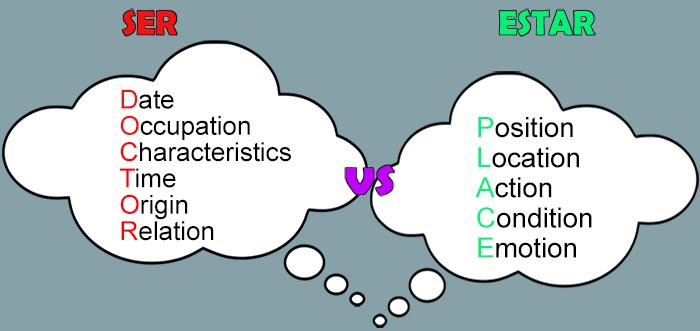There are two verbs in Spanish that can be translated as "to be": ser and estar. In the previous article, we've learnt about ways to use estar in Spanish and forms of estar. This lesson will focus on the correct usage of ser, ser conjugation in Spanish, and difference between ser and estar.
Conjugation of ser in Spanish
Ser comes in many conjugated forms:
Ser conjugation in the present tense:
| Subject | Ser conjugation | Translation |
| yo | soy | I am |
| tú | eres | You are |
| él/ella/usted | es | He/She is / You (formal) are |
| nosotros/nosotras | somos | We are |
| vosotros/vosotras | sois | You all are |
| ellos/ellas/ustedes | son | They/You all (formal) are |
Conjugation of ser in the future tense
| Subject | Ser conjugation | Translation |
| yo | seré | I am |
| tú | serás | You will be |
| él/ella/usted | será | He/She/You (formal) will be |
| nosotros/nosotras | seremos | We will be |
| vosotros/vosotras | seréis | You all will be |
| ellos/ellas/ustedes | serán | They/You all (formal) will be |
How to use ser in Spanish?
Though both ser and estar mean "to be", they are distinct verbs with different meanings to the native Spanish speaker.
1. User ser to indicate the existence
Ser is used merely to indicate that something exists.
For examples:
Ser o no ser, esa es la pregunta - To be or not to be, that is the question
Pienso, luego soy - I think, therefore I am
2. Use ser with adjectives for the inherent or essential characteristic
Use ser to describe the essential nature of something, not how something might be at a particular moment.
For examples:
La casa es grande - The house is big
La nieve es fría - Snow is cold
So this is different from estar.
For example: If you say "Estoy feliz", it might mean "I am happy at the moment." Estar is used to talk about something that is temporary while ser is used to talk about something permanent.
3. Use ser to indicate the origin, nature, or identity
Ser should be used to talk about someone's occupations, the origin of something, or the place where someone comes from or lives, and someone's religion.
For examples:
Somos de Argentina - We are from Argentina
Los billetes son de papel - The bills are made of paper
El papa es católico - The pope is Catholic
4. Use ser to indicate possession
For example:
El coche es mío - The car is mine
5. Use ser to form the passive voice
For examples:
Son usados para comer - They are used for eating
El gobernador fue arrestado en su propia casa - The governor was arrested in his own home
6. Use ser to tell time
You should use ser when telling time in Spanish
For examples:
Es la una - It is 1:00
7. Use ser to tell the location of events
While estar is often used for a direct statement of location, ser is used for the location of events.
For examples:
El concierto es en la playa - The concert is on the beach
La fiesta será en mi casa - The party will be at my house

Difference between ser and estar
8. Use ser in impersonal statements
For examples:
Es importante - It is important
Fue difícil pero necesario - It was difficult but necessary
